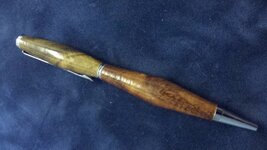GeoWade
Member
Hello all! I am a relative newbie, having made only about 20 pens, the last half dozen or so have had a CA finish. Take a look at a picture of one I just completed. I am starting to see these ridges on the finished pen. I don't think this is a sanding issue, but I'm not sure. My only guess is that I'm not smoothing the CA enough when I apply it. Has anyone seen this before, and if so, know what causes it?
Here's my process:
1. Sand with oxide sandpaper to 600 grit, both on the lathe and then length wise to remove circular sanding marks.
2. Apply Mylands Sanding Sealer.
3. Apply three coats of BLO / CA. (Dot of BLO on paper towel, then drop of medium CA, rub on blank while lathe is spinning. Wait for it to dry. Use accelerator on final coat.)
4. Sand with Micromesh wet.
5. Apply Meguiars scratch x remover.
6. Apply Mylands friction polish to finish.
Appreciate any guidance you might have on this one. The pen still looks good - I wouldn't hesitate it give it as a gift - but it does feel a little rough in the worst section, which I put towards the middle of the pen. I can only see the error if I look at the finish in the right light.
This is a koa wood / kou wood combo pen. I specialize in locally-obtained Hawaiian woods. Feel free to check out my Etsy store for more examples: https://www.etsy.com/shop/AlohaPens.
Thanks, Wade
Here's my process:
1. Sand with oxide sandpaper to 600 grit, both on the lathe and then length wise to remove circular sanding marks.
2. Apply Mylands Sanding Sealer.
3. Apply three coats of BLO / CA. (Dot of BLO on paper towel, then drop of medium CA, rub on blank while lathe is spinning. Wait for it to dry. Use accelerator on final coat.)
4. Sand with Micromesh wet.
5. Apply Meguiars scratch x remover.
6. Apply Mylands friction polish to finish.
Appreciate any guidance you might have on this one. The pen still looks good - I wouldn't hesitate it give it as a gift - but it does feel a little rough in the worst section, which I put towards the middle of the pen. I can only see the error if I look at the finish in the right light.
This is a koa wood / kou wood combo pen. I specialize in locally-obtained Hawaiian woods. Feel free to check out my Etsy store for more examples: https://www.etsy.com/shop/AlohaPens.
Thanks, Wade

